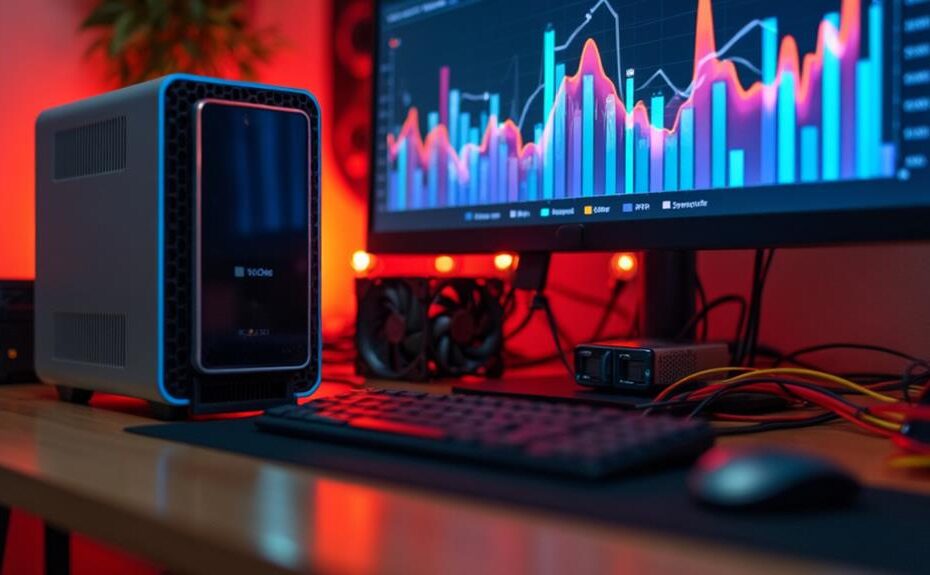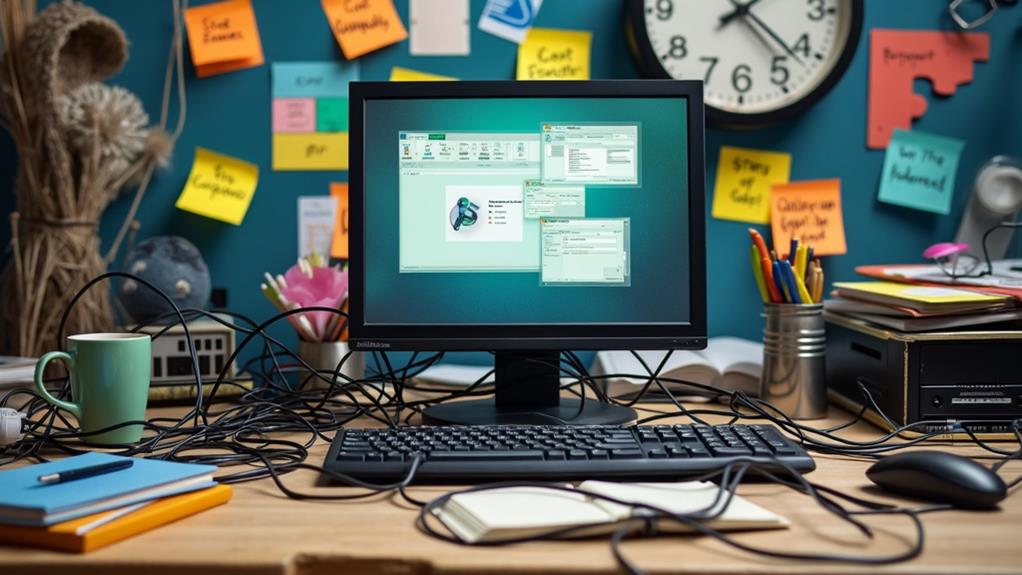



To prepare your mini PC for heavy data processing, start by selecting a powerful processor like Intel Core i9 or AMD Ryzen 7000 series. Confirm you have at least 16GB of RAM, ideally 32GB or more, for efficient data handling. Use an M.2 NVMe SSD, with a minimum of 1TB, to manage large datasets swiftly. A dedicated GPU, such as the NVIDIA RTX 3060, enhances performance for demanding tasks. Implement effective cooling solutions and confirm a stable power supply rated at 90W or higher. Finally, configure your network connectivity for peak data transfer speeds. Additional insights are just ahead.
Key Takeaways
- Select a high-performance processor, such as the Intel Core i9 or AMD Ryzen 7000 series, for optimal multitasking capabilities.
- Equip the mini PC with a minimum of 16GB RAM, ideally 32GB or more, for efficient handling of large datasets.
- Utilize M.2 NVMe SSD storage of at least 1TB for fast data retrieval and consider RAID configurations for redundancy.
- Incorporate a dedicated GPU, like NVIDIA RTX 3060, to enhance performance in data-intensive applications and ensure adequate GPU RAM.
- Implement effective cooling strategies, including high-quality thermal paste and proper airflow management, to maintain optimal operating temperatures.
Selecting the Right Processor
When it comes to selecting the right processor for heavy data processing in a Mini PC, you should prioritize high core counts and robust performance features. For instance, the GEEKOM Mini IT11, equipped with an 11th Gen Intel Core i7 processor, is an excellent choice for handling demanding tasks due to its powerful capabilities. Consider the Intel Core i7 or i9 options, particularly the i9-13900K, which boasts 24 cores. This capability greatly enhances multitasking during data analysis, allowing you to handle parallel processes more efficiently.
While Intel processors offer strong performance, don't overlook the AMD Ryzen 7000 series, which supports AVX-512. This feature can boost performance for specific heavy workloads, positioning it as a viable alternative. Regardless of your choice, make sure that the processor you select has a sufficient thermal design power (TDP) rating compatible with your cooling solutions. Maintaining ideal thermal conditions is essential during intense processing tasks.
Additionally, evaluate the clock speeds and cache sizes. Higher clock speeds can dramatically improve processing speeds, while larger caches enhance efficiency by reducing data retrieval times. By focusing on these vital factors—high core counts, TDP ratings, clock speeds, and cache sizes—you'll set your Mini PC up for effective and efficient heavy data processing.
Memory Specifications and Requirements
For heavy data processing tasks, having adequate memory is essential to guarantee smooth performance and efficiency. You'll want a minimum of 16GB RAM, but ideally, aim for 32GB or more to handle larger datasets effectively. The powerful AMD Ryzen 7 processor featured in many mini PCs enhances processing capabilities, making it vital to pair it with sufficient memory. Mini PCs typically utilize SODIMM or SDRAM, so verify that your chosen memory specifications align with these formats for compatibility.
When selecting RAM, opt for DDR4 to benefit from improved performance and efficiency. Before making a purchase, confirm your mini PC has the necessary DIMM slots available to avoid compatibility issues. Running out of memory can severely degrade performance; it's essential to have sufficient RAM to prevent reliance on slower storage solutions that could bottleneck data processing.
If you expect to work with increasingly larger datasets in the future, consider future-proofing your setup by investing in 64GB to 128GB RAM. This foresight can save you from potential upgrades down the line, guaranteeing your mini PC remains capable of handling demanding tasks. Prioritizing the right memory specifications now will set the foundation for efficient data processing in your mini PC.
Optimal Storage Solutions
To achieve ideal performance in heavy data processing tasks, selecting the right storage solution is vital. Opting for M.2 NVMe SSD storage can greatly enhance your data retrieval speeds compared to traditional 2.5-inch HDDs. With advanced features like those found in the top-notch quality of the DEPSTECH 4K Webcam, you can guarantee that your setup supports high-performance requirements. A minimum of 1TB SSD is recommended to handle large datasets efficiently and guarantee rapid access. If your projects demand even more capacity, consider additional external storage options.
Implementing RAID configurations further boosts your setup by improving data redundancy and enhancing read/write speeds. This approach not only safeguards your data but also provides a robust storage solution for intensive processing workloads. For archiving less frequently accessed data, pairing your SSD with a 4TB Seagate BarraCuda HDD can strike the right balance between performance and cost-effectiveness.
Always verify the reliability and durability of your storage drives. Consistent performance is critical when handling large amounts of data, so choose drives known for their reliability. By prioritizing ideal storage solutions, you're setting the stage for efficient data processing that meets your demanding needs.
GPU Considerations for Data Processing
In addition to selecting ideal storage solutions, considering the right GPU is vital for heavy data processing tasks. A dedicated GPU, such as the NVIDIA RTX 3060 or 3060 Ti, offers the power needed for machine learning and complex computations that a mini PC requires. You'll want to aim for a GPU with a minimum of 4GB of GPU RAM to effectively manage data science applications and larger datasets. While integrated graphics might work for basic tasks, a dedicated GPU will greatly enhance performance in data-intensive workloads.
When choosing a GPU, make certain it's compatible with your mini PC's power supply and case dimensions, as many high-performance GPUs demand more power and space. Additionally, evaluate the GPU's memory bandwidth and architecture. These factors play a vital role in the efficiency of data processing operations, particularly in parallel computing scenarios. By carefully selecting a dedicated GPU that meets these criteria, you'll set a solid foundation for tackling heavy data processing tasks effectively and efficiently.
Effective Cooling Strategies
While heavy data processing tasks can push your mini PC to its limits, effective cooling strategies are vital to maintaining peak performance. Increased workloads generate more heat, which can lead to thermal throttling and reduced CPU efficiency. To combat this, invest in high-quality thermal paste; it enhances heat transfer between the CPU and cooler. Pair it with an efficient CPU cooler, like the Noctua NH-L9i, to greatly improve heat dissipation and maintain ideal operating temperatures.
Additionally, guarantee proper case airflow by strategically placing fans. This setup facilitates better circulation, preventing hot air from accumulating inside the mini PC. If your build allows, consider installing additional case fans or upgrading to larger, more efficient models to bolster cooling performance, especially in compact environments.
Monitoring temperatures using software tools is essential. These tools can help you identify potential overheating issues, allowing for timely adjustments to your cooling solutions as needed. By implementing these effective cooling strategies, you can keep your mini PC running smoothly during demanding data processing tasks, maximizing your system's longevity and performance.
Ensuring Stable Power Supply
Effective cooling strategies set the stage for ideal performance, but without a stable power supply, even the best setups can falter. To guarantee your mini PC handles heavy data processing tasks, connect it to a reliable power source. Ideally, use a power supply rated at 90W or higher to prevent voltage drops during demanding operations. This is vital for maintaining system stability.
Consider incorporating a high-quality surge protector to shield your mini PC from unexpected power surges and fluctuations, which can lead to hardware damage. Additionally, utilize the power management settings in your operating system to optimize consumption and mitigate overheating risks during intense workloads.
Monitoring the voltage output of your power supply is essential; variations can trigger system resets or crashes under heavy load conditions. If your mini PC operates on a 5V micro-USB, upgrading to a 3-4A power source is necessary to guarantee it receives adequate power for demanding applications. By prioritizing a stable power supply, you'll enhance your mini PC's reliability and performance, allowing it to excel in data processing tasks without interruptions.
Configuring Network Connectivity
Configuring network connectivity is essential for guaranteeing your mini PC operates efficiently during heavy data processing tasks. Start by connecting your mini PC via a stable Ethernet connection, preferably using Cat5e or Cat6 cables. This setup allows for reliable data transfer, with a maximum distance of 100 meters (328 feet) for peak performance. Implement a local area network (LAN) to streamline connections, enabling direct communication between devices without relying on internet connectivity, which can be a bottleneck.
Check that your mini PC has enough USB 3.0 or 3.2 ports available for any external devices or storage solutions you may need during data processing and acquisition. If you're handling multiple devices, consider using mini routers equipped with multiple Ethernet ports to maintain stable connections across your network. Verify that all network settings are properly configured for seamless communication.
If you opt for wireless connections, monitor Wi-Fi signal strength closely. Weak signals can lead to instability, negatively impacting the performance of your data processing tasks on the mini PC. Prioritizing these steps will enhance overall network connectivity, guaranteeing your mini PC remains efficient during demanding workloads.
Disclosure: As an Amazon Associate, I earn from qualifying purchases.





